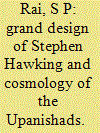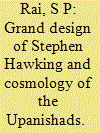| Srl | Item |
| 1 |
ID:
141395


|
|
|
|
|
| Summary/Abstract |
Stephen Hawking was born in 1942 on the anniversary of Galileo’s death. He holds Sir Isaac Newton’s chair as Lucasian Professor of Mathematics at Cambridge University and is widely regarded as one of the most brilliant theoretical physicists since Einstein
|
|
|
|
|
|
|
|
|
|
|
|
|
|
|
|
| 2 |
ID:
148857


|
|
|
|
|
| Summary/Abstract |
Chapters I and II appeared in the previous Volume (17:1) of Dialogue.
Chapter I discussed the philosophy of Cosmology and various related
questions raised in the introductory para of Stephen Hawking's book
Grand Design. Chapter II briefly summarised Stephen Hawking's
concept of cosmology in the Grand Design.
|
|
|
|
|
|
|
|
|
|
|
|
|
|
|
|
| 3 |
ID:
192481


|
|
|
|
|
| Summary/Abstract |
The article studies the diplomatic practice of building sustainable peaceful
relations in Europe. The authors conduct a comparative analysis of projects
intended to create pan-European forms of power, which at different times were proposed by European monarchs to ensure peaceful relations between
countries: Treaty on the Establishment of Peace throughout Christendom
by Bohemian King George of Poděbrady, the Grand Design by Henry IV,
and the Holy Alliance by Alexander I. Although similar to the European
monarchs’ initiatives in content and form, the Russian initiative implied
freer and more distributed institutional ties and rejected the idea of an
authorized pan-European body in favor of a broad association of European
monarchies. The concept of joint action, including non-expansionist
military intervention to preserve the natural process of social development
in Europe, was an important part of the Russian project. Anglo-Austro-
Russian team diplomacy, with the active peacemaking role of the Russian
emperor, succeeded in creating the first working pan-European order, and
the proposed institutions and principles ensured governable and peaceful
relations in Europe for almost a hundred years within the framework of the
Vienna system of international relations. Thus, instead of the unrealizable
idea of “perpetual peace,” the Austro-Russian tandem implemented the idea
of “perpetual struggle for peace,” but on diplomatic battlefields
|
|
|
|
|
|
|
|
|
|
|
|
|
|
|
|